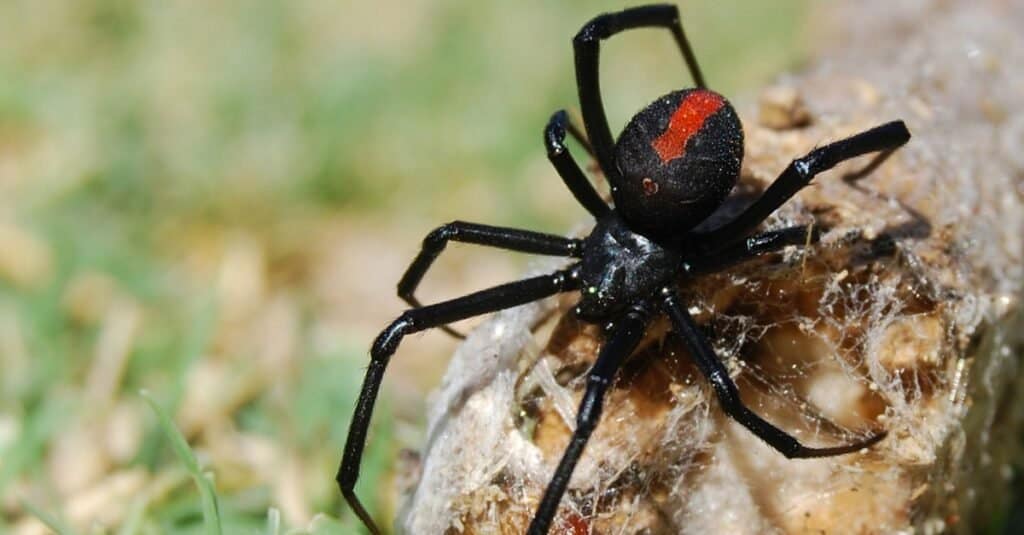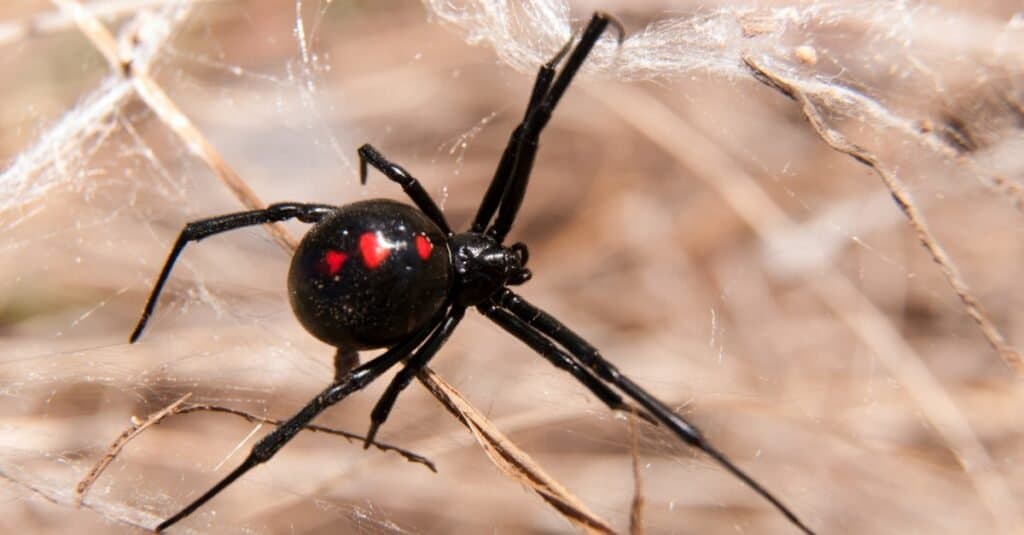Did you know that not only are there dangerous spiders in Texas but one of them is considered one of the most dangerous in North America? Texas is home to many Texas-sized things, but the lone star state is also home to some of the world’s tiniest venom slingers. There are almost 1,000 species of spiders in Texas, but only four of those have enough venom to potentially hurt a human.
Here, we’ll learn about the four most dangerous spiders in Texas. We’ll find out what they look like, where they live, what they eat, and how they hunt. Then, we’ll take a look at where to find each species. By the end, you’ll know how to identify these deadly spiders and how to avoid them.
Black Widow (Latrodectus mactans)

The black widow spider lives throughout North America, Central America and the West Indies.
©iStock.com/maria72
Black widow spiders just might be the most famous of the dangerous spiders in Texas. Females grow up to one inch long and have black bodies with characteristic red hourglass markings. Males grow to only ¼ inch long and look more brown than black. Black widows get their name from the females’ habit of eating the male after mating.
Black widow bites are often not very painful at the outset. But, their venom can produce intense nausea, muscle cramping, and even partial diaphragm paralysis, which can make it difficult to breathe. However, serious complications from black widow bites are rare in all but very young children and very old people. There have been no recorded deaths from black widows in the United States.
Where to Spot Black Widows
Black widows are outdoor spiders. They favor disused wood or debris piles and outdoor buildings, like sheds. They also live in or around animals’ burrows and foliage. The primary settings that draw black widows are those with insects to hunt and a suitable location for their webs.
Brown Recluse (Loxosceles recluse)

The brown recluse can also be found in the northern parts of the United States.
©Nick626/Shutterstock.com
Brown recluses are considered some of the most dangerous spiders in Texas, though bites are rare. These spiders grow up to one inch in leg span, with a ¼-inch long body. Brown recluses are also known as violin spiders because of the violin-shaped marking on their cephalothorax. They have long legs, large chelicerae (mouthparts), and tan abdomens.
Brown recluse spiders have very potent venom that has the potential to destroy the tissue surrounding the bite. The most common side effects of brown recluse bites are ulcers and tissue damage. Rarely bite wounds become infected and lead to the death of the victim. However, there have been few recorded deaths from brown recluse bites.
Where to Spot Brown Recluses
Brown recluse spiders don’t like high-traffic areas, but they prefer indoors. These dangerous spiders in Texas are most commonly found in attics, basements, closets, and pantries. Any little used part of a home, garage or other manmade structure may become home to a brown recluse.
Yellow Sac Spider (Cheiracanthium inclusum)

The yellow sac spider lives in all of the lower 48 states, as well as South and Central America.
©Austin Campbell / Creative Commons – License
Yellow sac spiders are small, with bodies around ¼ inch long and a leg span up to one inch, but they’re not shy. True to their name, yellow sac spiders tend towards yellow but may also be light brown or even yellow-orange. Their abdomens are long and pointed and lighter than their cephalothoraxes. Yellow sac spiders have large chelicerae and front legs that are longer than their other sets of legs.
Unlike some of the other dangerous spiders in Texas, yellow sac spiders do not spin webs. Instead, they actively hunt down and kill insects using their senses to detect the prey’s movement. Female yellow sac spiders are notoriously aggressive when it comes to defending their eggs, and will not hesitate to bite humans if they stray too close.
Where to Spot Yellow Sac Spiders
Yellow sac spiders commonly live indoors and have a habit of creeping into clothing or bedding that’s been left out. Unfortunately, when humans pick up the clothing, the yellow sac often bites in self-defense. Fortunately for victims, symptoms are mild, though the bite presents similarly to a bite from a brown recluse. Yellow sac spiders also live outdoors, particularly in gardens and low-lying foliage.
Brown Widow (Latrodectus geometricus)

There are brown widows in Texas, Japan, southern California, and Australia, among other places.
©Decha Thapanya/Shutterstock.com
Brown widows may not be as famous as black widows, but they’re still one of the most dangerous spiders in Texas. Unlike black widows, brown widows range from tan to dark brown in color. Their legs feature tan, black, and brown segments, while their cephalothoraxes are dark brown. The most striking feature of the brown widow is its abdomen, which is cream-colored with distinct markings. The underside of the abdomen features an orange hourglass marking akin to the red hourglass of the black widow.
Brown widow venom is much more potent than black widow venom. However, brown widows inject almost no venom when they bite, and they’re nonaggressive, so bites are extremely rare. Symptoms of a brown widow bite include redness and mild pain; complications are exceedingly rare. No deaths have been attributed to brown widows in the United States.
Where to Spot Brown Widows
Brown widows live outdoors in a variety of locales. They may be found in garages or garden sheds, as well as empty mailboxes or even on the insides of tires. Unlike black widows, who stick mostly under cover, brown widows come out in the open to build their nests and hunt. These dangerous spiders in Texas may also be seen in abandoned vehicles, brushes, or outdoor furniture.
How Many Venomous Spiders Are There?
The sheer number of species of spiders worldwide is quite staggering, with over 43,000 different kinds. Out of all these species, only a small fraction are known to be venomous and can pose a lethal threat to humans. They are especially harmful to children, who are even more susceptible than adults.
When one of these spiders bites its victim, it injects the venom through its hollow fangs directly into their bloodstream. Depending on the type of spider and the amount injected, this venom can cause paralysis or even death in extreme cases. Therefore it’s important to take caution when encountering any spider, not just those that have been identified as being particularly dangerous, and if bitten, seek medical attention immediately.

The Bold Jumping Spider is non-venomous
©Sari ONeal/Shutterstock.com
What Venomous Spiders Are in the USA?
The black widow spider is a common species found throughout the United States. It has an iconic, hourglass-shaped marking on its abdomen and is typically identified by its shiny black color. These spiders are considered to be quite dangerous as their venom can cause intense pain and nausea in humans when bitten.
The brown recluse spider is also native to North America and can be distinguished by its violin-shaped marking on the top of its head. Although bites from this species are rare, they have been known to cause severe tissue damage if not treated properly. Both of these species should be avoided entirely if possible, as no one wants to experience the adverse effects of their venom!

Black widows have highly toxic venom but are passive, shy creatures. They feed on cockroaches, earwigs, beetles, flies, and even other spiders.
©Sari ONeal/Shutterstock.com
Lifespan of a Spider
The spider’s lifespan can vary greatly based on the species. Some of the shorter-lived spiders include house spiders, which generally live one year or less. Wolf Spiders have a longer life span than house spiders, with males living for around one year and females living several breeding seasons – up to 2 to 3 years in captivity. Tarantulas are long-lived, with males living around 10 years and females reportedly living up to 35 years! One of the most extraordinary facts about spider lifespans is that trapdoor spiders can live past 40 years of age! It’s also worth noting that female spiders tend to outlive male spiders. After males reach maturity within two years, they usually die shortly after mating has occurred.
NEXT UP…
- Cane Spider
- Yellow Spiders: Joro Spider vs Garden Spider vs Banana Spider
- Venomous vs Poisonous Animals: 2 Key Differences Explained
The photo featured at the top of this post is © Vinicius R. Souza/Shutterstock.com
Thank you for reading! Have some feedback for us? Contact the AZ Animals editorial team.






